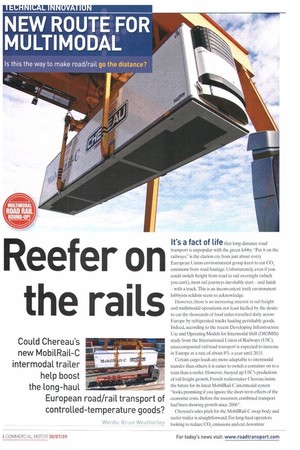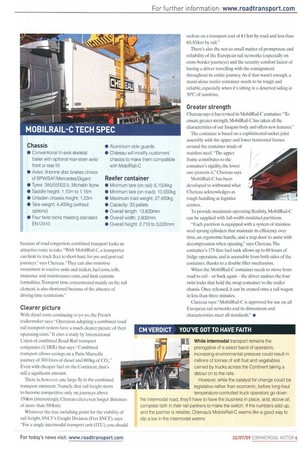Reefer on the .1
Page 44

Page 45

If you've noticed an error in this article please click here to report it so we can fix it.
Could Chereau's new Mobikail-C intermodal trailer help boost the long-haul European road/rail transport of controlled-temperature goods? It's a fact of life that long-distance road transport is unpopular with the green lobby. "Put it on the railways," is the clarion cry from just about every European Union environmental group keen to cut CO, emissions from road haulage. Unfortunately, even if you could switch freight from road to rail overnight (which you can't), most rail journeys inevitably start — and finish — with a truck. This is an inconvenient truth environment lobbyists seldom seem to acknowledge.
However, there is an increasing interest in rail freight and multimodal operations, not least fuelled by the desire to cut the thousands of food miles travelled daily across Europe by refrigerated trucks hauling perishable goods. Indeed, according to the recent Developing Infrastructure Use and Operating Models for Intermodal Shift (DIOMIS) study from the International Union of Railways (WC), unaccompanied rail/road transport is expected to increase in Europe at a rate of about 8% a year until 2015.
Certain cargo loads are more adaptable to intermodal transfer than others: it is easier to switch a container on to a train than a reefer. However, buoyed up t_IIC's predictions of rail freight growth, French trailermaker Chereau insists the future for its latest MobilRail-C intermodal system "looks promising if you ignore the short-term effects of the economic crisis. Before the recession, combined transport had been showing growth since 2006".
Chereau's sales pitch for the MobilRail-C swap body and reefer trailer is straightforward. For long-haul operators looking to reduce CO, emissions and cut downtime because of road congestion, combined transport looks an attractive route to take. "With MobilRail-C, a transporter can limit its truck fleet to short-haul, for pre and post-rail journeys," says Chereau. "They can also minimise investment in tractive units and trailers, fuel costs, tolls, insurance and maintenance costs, and limit customs formalities.Transport time, concentrated mainly on the rail element, is also shortened because of the absence of driving time restrictions."'
Clearer picture
With diesel costs continuing to yo-yo, the French trailermaker says: "Operators adopting a combined road/ rail transport system have a much clearer picture of their operating costs." It cites a study by International Union of combined Road-Rail transport companies (UIRR) that says: "Combined transport allows savings on a Paris-Marseille journey of 300 litres of diesel and 800kg of CO; Even with cheaper fuel on the Continent, that's still a significant amount.
There is, however, one large fly in the combined transport ointment. Namely, that rail freight starts to become competitive only on journeys above 150km (interestingly, Chereau cites even longer distances of more than 500km).
Whatever the true switching-point for the viability of rail freight, SNCF's Freight Division (Fret SNCF), says: "For a single intermodal transport unit (ITU), you should reckon on a transport cost of €1/km by road and less than €0.50/km by rail."
There's also the not-so-small matter of promptness and reliability of the European rail networks (especially on cross-border journeys) and the security comfort factor of having a driver travelling with the consignment throughout its entire journey. As if that wasn't enough, a stand-alone reefer container needs to be tough and reliable, especially when it's sitting in a deserted siding in 30°C of sunshine.
Greater strength
Chereau says it has revised its MobilRail-C container. "To ensure greater strength. MobilRail-C has taken all the characteristics of our lnogam body and offers new features."
The container is based on a sophisticated socket joint assembly with the upper and lower horizontal frames around the container made of stainless steel. The upper frame contributes to the container's rigidity, the lower one protects it," Chereau says.
MobilRail-C has been developed to withstand what Chereau acknowledges as rough handling at logistics centres.
To provide maximum operating flexibity, MobilRail-C can be supplied with full-width insulated partitions.
"Each partition is equipped with a system of stainless steel sprung cylinders that maintain its efficiency over time, an ergonomic handle, and a trap door to assist with decompression when opening," says Chereau.The container's 175-litre fuel tank allows up to 60 hours of fridge operation, and is accessible from both sides of the container, thanks to a double filler mechanism.
When the MobilRail-C container needs to move from road to rail or back again the driver undoes the four twist locks that hold the swap container to the trailer chassis. Once released, it can be craned onto a rail wagon in less than three minutes.
Chereau says: "MobilRa il-C is approved for use on all European rail networks and its dimensions and characteristics meet all standards." •












































































































































